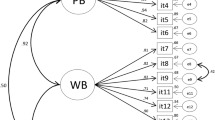Abstract
This study examined the psychometric properties of two selected scales-’personal burnout’ and ’work-related burnout’-from the Chinese version of the Copenhagen Burnout Inventory (C-CBI) in 384 employees from two companies in Taiwan. A selfadministered questionnaire was used that included the two C-CBI scales, the scales of mental health, vitality and general health from the Short Form 36 (SF-36), perceived level of job stress, job satisfaction, working hours, as well as measures for psychological job demands, job control, work-related social support, and over-commitment to work. Both the C-CBI personal burnout scale and work-related burnout scale had high internal consistency and were correlated well with other health, job characteristics, and perception of work measures; furthermore, exploratory factor analysis extracted two empirical factors. However, the two C-CBI scales were highly correlated in the present population and appeared to measure overlapping concepts. Some comments and suggestions were raised for further improvement.
Similar content being viewed by others
References
Borritz, M., & Kristensen, T. S. (2001).Copenhagen Burnout Inventory: Normative data from a representative Danish population on personal burnout and results from the PUMA study on personal burnout, work burnout, and client burnout. Retrieved January 13, 2005, from http://www.ami.dk/upload/ udgivelser/cbi data uk.pdf
Borritz, M., Bultmann, U., Rugulies, R., Christensen, K. B., Villadsen, E., & Kristensen, T. S. (2005). Psychosocial work characteristics as predictors for burnout: Findings from 3-year follow up of the PUMA study.Journal of Occupational and Environmental Medicine, 47(10), 1015–1025.
Cheng, Y., Luh, W.-M., & Guo, Y.-L. (2003). Reliability and validity of the Chinese version of the job content questionnaire in Taiwanese workers.International Journal of BehavioralMedicine, 10(1), 15–30.
Institute of Occupational Safety and Health (IOSH) (1994).Survey of employee’s perceptions of safety and health in the work environment. Taipei, Taiwan: The Council of Labor Affairs Institute of Occupational Safety and Health.
Institute of Occupational Safety and Health (IOSH) (2004).Taiwan labor’s job-burnout and related psychosocial factor survey in 2004. Taipei, Taiwan: The Council of Labor Affairs Institute of Occupational Safety and Health.
Karasek, R. (1985).Job content instrument questionnaire and user’s guide, version 1.1. Los Angeles: University of Southern California.
Karasek, R., & Theorell, T. (1990).Healthy work. Stress, productivity, and the reconstruction of working life. New York: Basic Books.
Kleinman, A. (1986).Social origins of distress and disease: Depression, neurasthenia, and pain in modern Chin. NewHaven and London: Yale University Press.
Kristensen, T. S., Borritz, M., Villadsen, E., & Christensen, K. B. (2005). The Copenhagen burnout inventory. A new tool for the assessment of burnout.Work & Stress, 19(3), 192–207.
Li, J., Yang, W., Cheng, Y., Siegrist, J., & Cho, S.-I. (2004). The reliability and validity of the Chinese version of effort-reward imbalance questionnaire among health care workers: A validation study.International Archives of Occupational and Environmental Medicine, 78(3), 198–204.
Maslach, C., & Johnson, S. (1986).MBI: Maslach burnout inventory: Manual research editio.. Palo Alto, CA: University of California, Consulting Psychologists Press.
SAS Institute, Inc. (1999).Statistical analyses system. Version 8.2. North Carolina: Cary.
Schaufeli, W., & Buunk, B. (2003). Burnout: An overview of 25 years of research and theorizing. In M. Schabracq, J. Winnubst, & C. Cooper (Eds.),Handbook of work and health psychology (pp. 383–429), West Sussex, UK.: Wiley.
Siegrist, J., Peter, R., Junge, A., Cremer, P., & Seidel, D. (1990). Low status control, high effort at work and ischemic heart disease: Prospective evidence from blue-collar men.Social Science and Medicine, 31, 1127–1134.
Ware, J. E., & Sherbourne, C. D. (1992). The MOS 36-item shortform health survey (SF-36). I. Conceptual framework and item selection.Medical Care, 30, 473–483.
Winwood, P. C., & Winefield, A. H. (2004). Comparing two measures of burnout among dentists in Australia.International Journal of Stress Management, 11(3), 282- 289.
Winwood, P. C., Winefield, A. H., & Lushington, K. (2003). The role of occupational stress in the maladaptive use of alcohol by dentists: A study of south Australian general dental practitioners.Australian Dental Journal, 48(2), 102–109.
Author information
Authors and Affiliations
Corresponding author
Additional information
This study was supported by the Institute of Occupational Safety and Health, Council of Labor Affairs (IOSH93-M308), and a research grant from the National Science Council (NSC-93-2320-B002-083), Taiwan. The authors thank volunteers who kindly agreed to participate in this study.
Rights and permissions
About this article
Cite this article
Yeh, WY., Cheng, Y., Chen, CJ. et al. Psychometric properties of the chinese version of copenhagen burnout inventory among employees in two companies in Taiwan. Int. J. Behav. Med. 14, 126–133 (2007). https://doi.org/10.1007/BF03000183
Issue Date:
DOI: https://doi.org/10.1007/BF03000183



